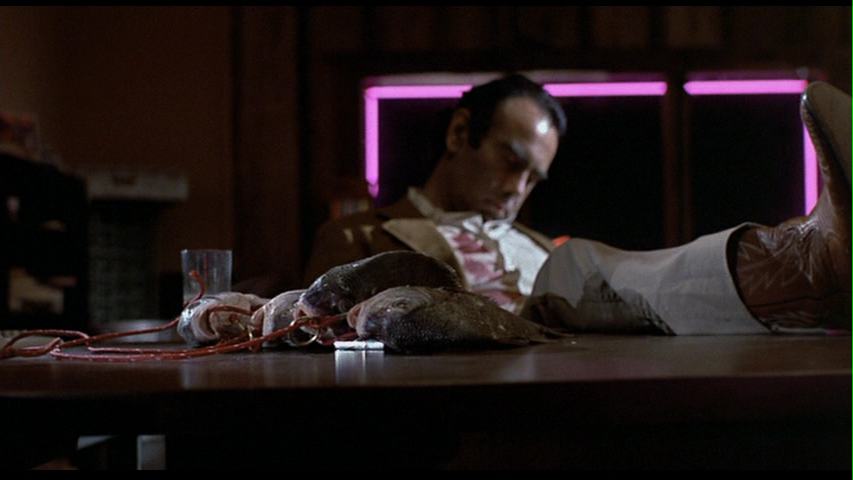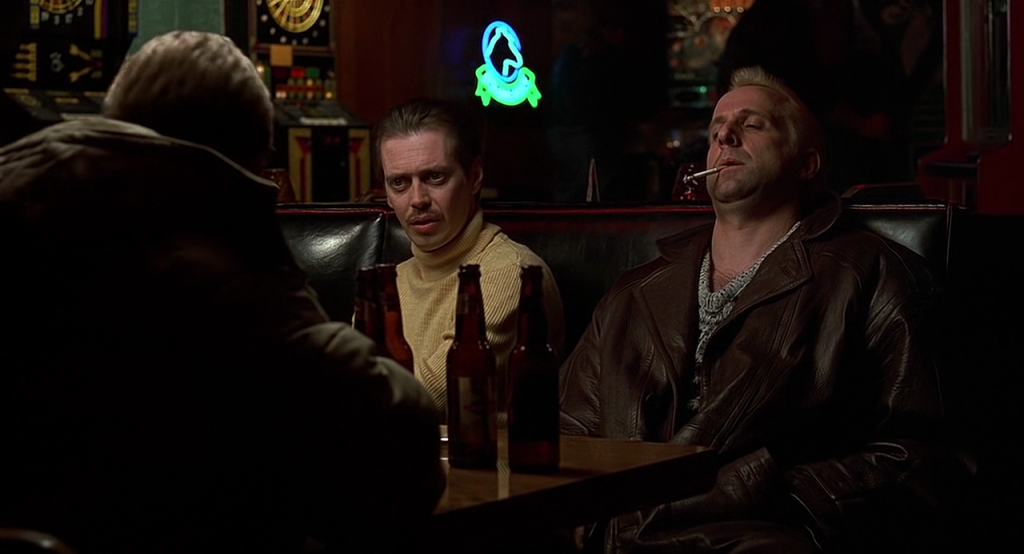Raw Intelligence! The Coens’ Craziness and the Constitutive Inconsistency of the Signifier
These reflections were included in Apropos of Nothing: Deconstruction, Psychoanalysis, and the Coen Brothers (SUNY, U.P.). They can be cited here as: Buckner, Clark. “What, for the Coens, Does It Mean to be ‘Blood Simple?’” www.clarkbuckner.com. Web. Day, Month, Year article as accessed.
In Blood Simple’s opening scene, Abby (Frances McDormand) flees her jealous husband, Marty (Dan Hedaya), in a car driven by one of the bartenders who works in his honky-tonk. Suddenly she yells out, “Stop the car, Ray!” The car comes screeching to a halt and the private detective on their tail almost rear-ends them. Ray (John Getz) supposes that Abby suspected they were being followed; but she asks instead, “What was that back there?”
“What?” Ray responds in kind.
She clarifies, “A sign.”
While the sign in question proves to be familiar enough, advertising a roadside motel to which the two shortly retreat, before and beyond the drama of their tryst, as correlative to their formal play with genre conventions, it establishes the importance for the film – and ultimately for the Coens’ oeuvre as a whole – of signifying systems.
In Blood Simple, the Coens further develop this theme through the formal device of the telephone and the gap it institutes between seeing and hearing. The next morning in the motel, the ringing of the telephone wakes Abby and Ray. A voice on the end of the line asks menacingly, “Are you having fun?” When Ray responds, “Who is this?” the voice retorts, “I don’t know, who is this?” In this case, despite their unanimous assertions of ignorance, everyone knows exactly who’s who and what’s going on. After Ray hangs up, Abby asks, “Who was it?” Ray answers, “your husband.” Later, however, precisely this presupposition of mutual recognition unravels. The next day, when Ray returns from talking to Marty, who insists that Abby is using Ray, and will betray him too, she is on the telephone. The audience knows that Marty is on the other end of the line, but he says nothing. When Ray walks in the room, he asks accusingly, “who was it?” Startled, Abby turns around, “What?” He continues, “On the phone.”
“I don’t know.”
“Was it for you?”
“I don’t know,” she explains, “He didn’t say anything.”
“How’d ya know it was a he?”
Abby answers, “You gotta girl? Am I screwing something up?”
“No,” Ray accuses, “Am I?”
While nothing transpired on the telephone, by the end of the exchange, the two are at odds. Ray is defensive; and, despite the fact that he and Abby just recently became lovers, they now are deciding, who – at least initially – will sleep on the couch.
The telephone interjects an absence into the exchanges between Abby and Ray. Not only is there silence at the other end of the line, leaving Abby ignorant of who might be there, but also Ray can’t hear what she is or, in fact, isn’t hearing. In philosopher Jacques Derrida’s terms, the technological mediation of the telephone, and the gap it institutes between seeing and hearing, constitutes the phoneme, spoken into the receiver, as a grapheme, a written mark characterized by a second-order of absence: the representation of a representation, as captured by the etymology of “tele” as “far,” which renders it irreducible to the context of its articulation; and this same negativity infects the reliability of their spoken exchange.
In the crime scene at the center of the film, the Coens present this same “supplementary” absence in the texture of immediately given experience. In fulfillment of Marty’s contract to murder Abby and Ray, the private detective provides him with a doctored photograph of the two in bed, riddled with bullet holes. He takes Marty’s money and then shoots him with Abby’s gun. The double-cross depends upon Marty’s misunderstanding of the photograph, and subsequently this crime scene in Marty’s office at the bar becomes the locus of the misrecognitions that drive the remainder of the film, as a collection of evidence: the gun on the floor, the body, the missing body, the broken glass, the fish on the desk, the hammer on the safe. In the film – and, in fact, in any crime scene – these details function not merely as facts, but rather signifiers, which promise to explain what transpired. Contrasting Blood Simple with the novels of James M. Cain to which it is deeply indebted, critic Stanley Orr accordingly writes,
“If Cain’s protagonists doom themselves through compulsive, transgressive action, the Coens’ spend most of their time trying either to read ‘signs’ that provide a basis for action or producing texts that misdirect the actions of others. The narrative emerges from such misreadings and is therefore impeded by interpretive paralysis. Each character, not exempting the viewer, succumbs to a textualized world in which the distinction between meaning and meaninglessness becomes hopelessly blurred” (Orr, 2008).
Following his murder, the details of Marty’s office constitute a field of signifying evidence. How one understands them depends upon determining the hermeneutical framework that would establish their relationship to one another, give them a narrative context, and define their significance. However, in so far as the evidence itself does not provide this framework, any understanding of the scene thus remains at best auxiliary, riddled with confusion and subject, always again, to revision.
With particular attention to the hypermodern information technologies of the surveillance apparatus and the Internet, in Burn After Reading, the Coens similarly thematize the mediation of experience by signifying systems, and the gaps they institute in everyday life. At the center of the film’s plot is a computer disc, which accidentally is misplaced in the locker room at a “Hardbodies” gym. The information on the disc belongs to Osborne “Ozzie” Cox (John Malkovich), a pretentious, but presumably low-level researcher for the
CIA, who quits his job at the outset of the film, rather than accept a demotion, apparently because he has a drinking problem. At a loss for how to proceed with his career, he resolves to write a memoir while trying to drum up work as a consultant. The Coens satirize Ozzie as grandiose in his self-importance. He waxes into a tape recorder, “We were young and committed, and there was nothing we could not do…” but his reflections go nowhere and – establishing the fact that he’s written very little – soon he’s seen watching game shows on television and waiting until five o’clock to fix himself his first cocktail. The disc includes Ozzie’s first attempts at writing along with the figures from his bank accounts. Unbeknownst to him, the files from his computer have been copied onto the disc by his wife, Katie (Tilda Swinton) – who is so cold and stuck up that she’s perhaps best addressed by her professional title as Dr. Cox. She plans to divorce Ozzie and copied his financial information off his computer to share with her lawyer, only accidentally adding the sketchy notes for his memoir. Her lawyer’s assistant mislaid the disc at Hardbodies.
As Chad Feldheimer (Brad Pitt), one of the trainers at the gym, reads through the data, the language of the CIA reflexively calls attention to the information as information, “It’s these files, man… Talking about SIGNT and signals and shit and… ‘Signals’ means ‘code,’ you know. Talking here about department heads and their names and shit.” It’s code for code. He continues, “And then there’s these other files that are just, like, numbers. Arrayed. Numbers and dates and numbers and numbers, …and dates. And numbers and…” Listing these numbers and dates Chad further distills the information on the disc to the pure function of the signifier, discerning the deepest meaning in it precisely at the point where it has become utterly meaningless. Pointing at the computer screen, he concludes, “I think that’s the shit, Man. The raw intelligence.”
Despite the absurdity of Chad’s melodrama, his recognition of the meaningless numbers and dates as the essence of the information indeed corroborates Derrida’s concept of différance, as a fundamental nonsense that conditions the possibility of sense; and the conspiracy surrounding the disc results from the dissemination of its displacement. When Chad and his co-worker, Linda Litsky (Frances McDormand), call Ozzie, offering to return his disc and hoping perhaps thereby to earn a reward, Chad whispers into the telephone with a stilted cloak and dagger voice. He introduces himself as a “good Samaritan,” which sounds almost like a code name, despite the fact that it’s also perfectly true; and he explains, again honestly but in a way that sounds almost menacing, “I thought you might be worried about the security of your shit.” Ozzie, of course, doesn’t know about the computer disc at all and can’t imagine what Chad might be talking about. But, when Chad reads to him from his notes, his contemptuous irritation grows into unrestrained fury, and adds to the confusion. In response to the suggestion of a reward, Ozzie concludes that Chad and Linda are extortionists. Despite the fact that originally, they offered to return Ozzie’s disc, only hoping that they might be rewarded accordingly, by the end of the exchange, they are indeed demanding money for the disc, at odds with Ozzie, and involved in, what they take to be, a political conspiracy.
In Fargo, the breakdown in communication similarly plays a central role in the dramatic unfolding of the films’ absurd disasters. When first introducing himself to Carl and Gear, Jerry cites the ex-con mechanic (Steven Reevis) who referred him to them, “Shep Proudfoot said…”
Carl interrupts, “Shep said you’d be here at 7:30. What gives, man?”
Jerry protests, “Shep said 8:30.”
But Carl insists, as if offering proof to the contrary, “We’ve been sitting here an hour. He’s peed three time already.”
“I’m sure sorry,” Jerry concedes. “Shep told me 8:30. It was a mix-up, I guess.”
If Blood Simple begins with the private detective’s ominous proclamation that, down here, “something always can go wrong,” in Fargo, something has gone wrong even before the film begins: “a mix-up” about what “Shep said.” And, in various ways, the disasters that ensue, reverberate the gap in this initial misunderstanding.
Moreover, beyond such conspicuous attention to the underdetermination of the signifier, Critic R. Barton Palmer contends that, in Fargo, the Coens deconstruct the binary moral oppositions, which frame the story, between the villainous and the virtuous, the criminal and the commonplace, and, what he calls, the everyday and the exotic. If Jerry is oblivious to the violence he unleashes, Palmer argues, so is Marge Gunderson (Frances McDormand), the pregnant Police Chief who pursues the wreckage of his disastrous plot. Despite the horror she uncovers, Marge remains all but unmoved. She reflexively turns away from it, steadfastly committed to her sense of the ordinary without any inkling of disillusionment. In their utter banality, Palmer argues, the upstanding citizens who populate the film thus exhibit the sense of self-possession that subtends Jerry’s crimes – a point that one might press still further, by connecting the “mix-up” about what “Shep said” to the empty chatter of the broader social milieu. Palmer writes, “The everyday envelops the exotic, expressing and yet suppressing its strangeness.” And here, he contends, is the film’s political point: “contemporary American culture, even in its most mild-mannered mid-continental version, manifests a Hobbesian underside that can erupt at any time into homicidal fury” (Palmer, 2004; 100).
But is this differential underdetermination of signifying systems and correlative deconstruction of metaphysical binaries, indeed, sufficient to account for the irrationality in the Coen Brothers’ movies? What, after all, makes the underside of American culture specifically “Hobbesian”?






